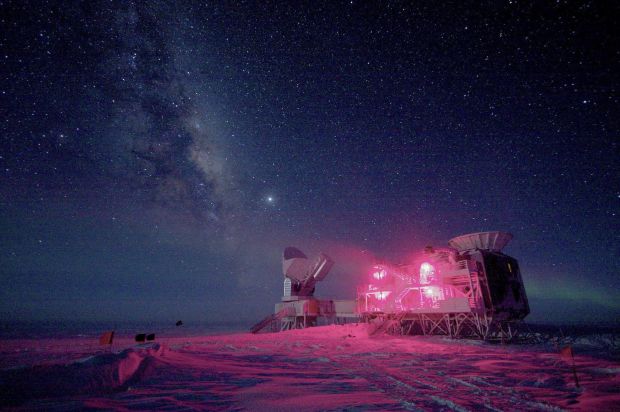
The South Pole Telescope and the Background Imaging of Cosmic Extragalactic Polarization experiment, or Biceps2, at Amundsen-Scott South Pole Station are seen against the night sky in this National Science Foundation picture from 2008. Pope Francis appointed Dutch astrophysicist Ewine Fleur van Dishoeck, who studies interstellar gases, to the Pontifical Academy of Sciences July 30, along with epidemiologist Chen Chien-jen, chemist Susan Solomon and physicist Donna Strickland. (CNS photo/Keith Vanderlinde/National Science Foundation via Reuters)
VATICAN CITY (CNS) — Pope Francis has appointed to the Pontifical Academy of Sciences an epidemiologist credited with handling Taiwan’s response to COVID-19, a global expert in atmospheric chemistry credited with helping to explain the cause of the “hole” in the ozone layer over Antarctic in the 1980s and a Canadian Nobel laureate in physics who works with lasers.
Chen Chien-jen, the epidemiologist, was vice president of Taiwan from May 2016 to May 2020. The Vatican announced his appointment to the academy July 30.
Susan Solomon is a chemist and professor of environmental studies at the Massachusetts Institute of Technology. Her appointment to the academy was announced July 31.
[hotblock]
Donna Strickland is an optics physicist and professor at Ontario’s University of Waterloo; in 2018 she and Gérard Mourou won the Nobel Prize in physics for their development of chirped pulse amplification, a process for creating the intense laser pulses now used in industry and medicine, including for laser eye surgery. Her appointment was announced Aug. 2.
Ewine Fleur van Dishoeck is a Dutch professor of molecular astrophysics, who studies the clouds of gas found between stars, the development of new stars and has helped develop telescopes. The Vatican announced her appointment Aug. 3.
The Pontifical Academy of Sciences, founded in 1603, brings together top scientists from a variety of disciplines to study and discuss the latest developments in scientific research and to advise the Vatican on matters involving science. The members, many of whom are Nobel laureates, are chosen for their expertise; many of the almost 80 members are not Catholic.
Chen, however, is Catholic. He was a member of the board of trustees of Fu Jen Catholic University and taught there in 2009-2015. He also is a member of the Equestrian Order of the Holy Sepulchre.
After earning a master’s degree in public health from National Taiwan University, he earned his doctorate in epidemiology and human genetics from Johns Hopkins University in 1982. His research has focused on the long-term health hazards of environmental agents, such as arsenic, and on cancer risks of various hepatitis viruses.
When he finished his term as vice president, he returned to Taipei’s Academia Sinica as a professor and researcher.
[hotblock2]
Solomon worked for decades at the U.S. National Oceanic and Atmospheric Administration, conducted research in Antarctica and was a member of the Intergovernmental Panel on Climate Change that shared the 2007 Nobel Peace Prize with former Vice President Al Gore.
She is the founding director of MIT’s Environmental Solutions Initiative, a university-wide coalition of experts working to address the challenges posed by climate change.
Strickland, who was born in Guelph, earned a PhD in optics from the University of Rochester, New York, and conducted her Nobel-winning research there with Mourou while still a student.
She has worked as a research associate at the National Research Council of Canada, a physicist at Lawrence Livermore National Laboratory in California and at Princeton University’s Advanced Technology Center for Photonics and Opto-electronic Materials. In 1997, she joined the University of Waterloo, where her ultrafast laser group develops high-intensity laser systems for nonlinear optics investigations.
Van Dishoeck teaches at Leiden University in the Netherlands and conducts her research from the Leiden Observatory. Her university homepage explains that “the basic chemistry in space and the study of star and planet formation form the main thrust of our research,” part of which is focused on the development of water on Earth and its potential existence on other planets.
PREVIOUS: Bishops say Spain trying to ‘dismantle the Christian worldview’
NEXT: True joy comes from doing God’s will, pope tells young people



Share this story